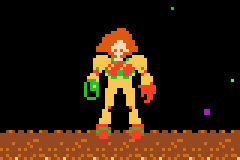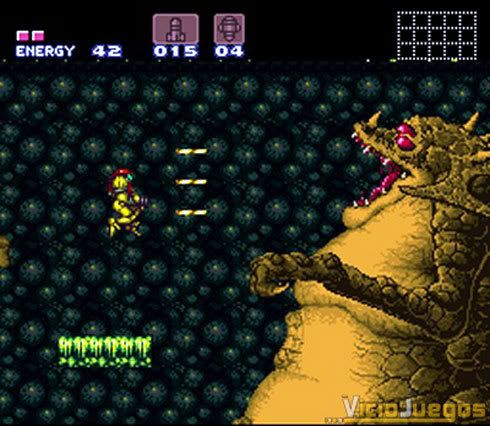Origins of Metroid
 I can't talk about Super Metroid without getting into the original NES game, Metroid. The original game was released in 1986, while the NES was still growing. When the game came out people everywhere were entraced with the game and it quickly became a hit. It played very differently than most games of the day. While it was still a side-scroller it had no level progression. Samus Aran, the hero of the Metroid series, is just dropped into a world and it is up to the player to figure out where to go. The goal of the game was to earn different power ups, each one adding to Samus' techniques allowing her to get through previously blocked areas. People spent hours trying to figure out where they were and where to go next, or would pick up the latest Nintendo Power to get a map of the game. In hindsight, the game was actually a little too confusing, without a map in the game and the basic graphics of the NES it was hard to tell if you were progressing or backtracking. While it was still a major breakthrough in video game design it still needed a bit more polish to become a truely great game.
I can't talk about Super Metroid without getting into the original NES game, Metroid. The original game was released in 1986, while the NES was still growing. When the game came out people everywhere were entraced with the game and it quickly became a hit. It played very differently than most games of the day. While it was still a side-scroller it had no level progression. Samus Aran, the hero of the Metroid series, is just dropped into a world and it is up to the player to figure out where to go. The goal of the game was to earn different power ups, each one adding to Samus' techniques allowing her to get through previously blocked areas. People spent hours trying to figure out where they were and where to go next, or would pick up the latest Nintendo Power to get a map of the game. In hindsight, the game was actually a little too confusing, without a map in the game and the basic graphics of the NES it was hard to tell if you were progressing or backtracking. While it was still a major breakthrough in video game design it still needed a bit more polish to become a truely great game.Samus is a WHAT????? (Character design)
 One of the greatest moments in Metroid, or any other video game, was the ending to the original NES game. When you beat the game Samus takes off her helmet and you find out she is a girl. This moment is not just a cheesy reveal but plays on typical video game cliches. 99% of games are starring male characters, and the games that do star females usually feature her dressed in some pretty pink outfit, or barely wearing anything at all being overly sexualized. Samus Aran is the complete opposite of this. She is dressed in full body armor without a hint of skin appearing. Also Female characters in games follow specific gameplay traits, namely they are fast and weak. Samus Aran isn't particularly fast, and she is anything but weak under all her armor and weapons. The game designers, rather than coming out and telling everyone Samus was a girl, decided to hide the true identity until the end of the game. This was the game designers covering their bases. Games are mostly designed and played by males. It does not take a leap in logic to see that if everyone knew Samus Aran was a girl little boys might not want to pick up the game, and would rather play Contra again. By hiding her true gender until the end, it let players know it is not so bad playing as a strong female.
One of the greatest moments in Metroid, or any other video game, was the ending to the original NES game. When you beat the game Samus takes off her helmet and you find out she is a girl. This moment is not just a cheesy reveal but plays on typical video game cliches. 99% of games are starring male characters, and the games that do star females usually feature her dressed in some pretty pink outfit, or barely wearing anything at all being overly sexualized. Samus Aran is the complete opposite of this. She is dressed in full body armor without a hint of skin appearing. Also Female characters in games follow specific gameplay traits, namely they are fast and weak. Samus Aran isn't particularly fast, and she is anything but weak under all her armor and weapons. The game designers, rather than coming out and telling everyone Samus was a girl, decided to hide the true identity until the end of the game. This was the game designers covering their bases. Games are mostly designed and played by males. It does not take a leap in logic to see that if everyone knew Samus Aran was a girl little boys might not want to pick up the game, and would rather play Contra again. By hiding her true gender until the end, it let players know it is not so bad playing as a strong female.Super Metroid: Like Metroid but Super.
 In 1994 Super Metroid came out and it was bascially everything Metroid could have been and more. In many ways Metroid was so far ahead of its time, technology had to catch up to it for it to be fully realized. Super Metroid came out looking better, sounding better, and it had a map so you didn't get lost. Keeping with the tradition of the first game, you are just dropped into a world and its up to the player to figure out how to progress. The newly added map fills in only when you get to an area, or when you get to a map room, which helps keep the game mysterious while not becoming frustrating.
In 1994 Super Metroid came out and it was bascially everything Metroid could have been and more. In many ways Metroid was so far ahead of its time, technology had to catch up to it for it to be fully realized. Super Metroid came out looking better, sounding better, and it had a map so you didn't get lost. Keeping with the tradition of the first game, you are just dropped into a world and its up to the player to figure out how to progress. The newly added map fills in only when you get to an area, or when you get to a map room, which helps keep the game mysterious while not becoming frustrating.
Exploration
I mentioned before how important exploration is to the Metroid series. Much like Zelda the way you level up your character is not gaining experience points, but by finding new weapons and abilities that enhance the gameplay. This not only gives an organic feel to your character growing over time, but adds to the open world game design. One of the major pitfalls, that developers can fall into, is backtracking through older areas. Seeing the same environment over again and fighting the same enemies can get boring. Luckily, the map is designed in such a way that the anytime you have to backtrack you have your new weapons and abilities that change the gameplay of the familiar area. Old areas feel new, and old fighting enemies become easier. The way Samus plays at the beginning of the game is very different from how she plays at the end. The change is so gradual over the game that the player is never overloaded with too much to learn at once. Because of this, there is a sense of pride the player has when they see how much they helped Samus accomplish. This ties the player to the hero in a way that very few games can do, which is why so many people have fond memories playing this game. Being able to connect the player and Samus is a true form of art.
Their are many bosses scattered throughout Super Metroid. They are all much bigger than a normal enemy in the game, and they take a lot more skill to defeat. Usually you can only beat bosses by using your new found powers, along with a mix of convential gameplay. Sometimes it takes as much puzzle solving to beat it as it does to find it. The overall theme of the game is still strong while in the heat of an epic battle. Even when the action on screen looks tense, the only way to beat a boss is with strategy. Some bosses even have multiple ways to beat it, giving each player a different experience. One such boss can be killed with patience and well timed shots, or you can literally sacrifice Samus' health and let the boss capture you and then drag yourself and it into an eletric field. One way is fast, and easy but dangerous, and the other is slow and takes skill. In many ways the bosses are perfect conclusions to each section of the game. The player needs to use everything he/she learned to defeat the boss. There is a sense of accomplishment after defeating the boss that is almost unmatched in most other games.
The Music
Metroid is unique in more ways than just its gameplay. The music for the series is some of the most unique in any video game. Samus Aran looks like a big tough bounty hunter with an array of weapons and you would think the music would reflect that. However, it is too easy and common to simply create an action oriented score. Rather than fall into the typical traps, the composers decidided to emphasize the mysterious atmosphere. Through most of the game the music is creepy, and slow. The musical score of the game has more in common with horror movies than action. Since this game constantly has the player on his/her toes guessing what to do next, the music enhances this mood.
A typical song in Super Metroid, this particular song is for Brinstar. As you move from area to area the music changes but the theme of the music never does. Since most of the game happens underground or in enclosed spaces the music has a low echo sound to it. Since the game is fairly complex and non linear the music throughout all the areas should keep with the players emotion of confusion.
The music does pick up a few times throughout the game. The most common time the music gets a faster pace is the boss fights. It is the only area in the game where the player's main concern is battle. The music has to pick up in order to set the player in the mood for quicker thinking and faster reflexes. Even though the music is faster it still maintains the overall theme of the game. The music is still low sounding and keeps the echo. The transition from the slower exploration music to the boss battles is smooth because of this.

http://www.youtube.com/watch?v=yEVW4WWdHNo
ReplyDeleteIt's great to see people still appreciate this game, it's brilliant!
ReplyDelete